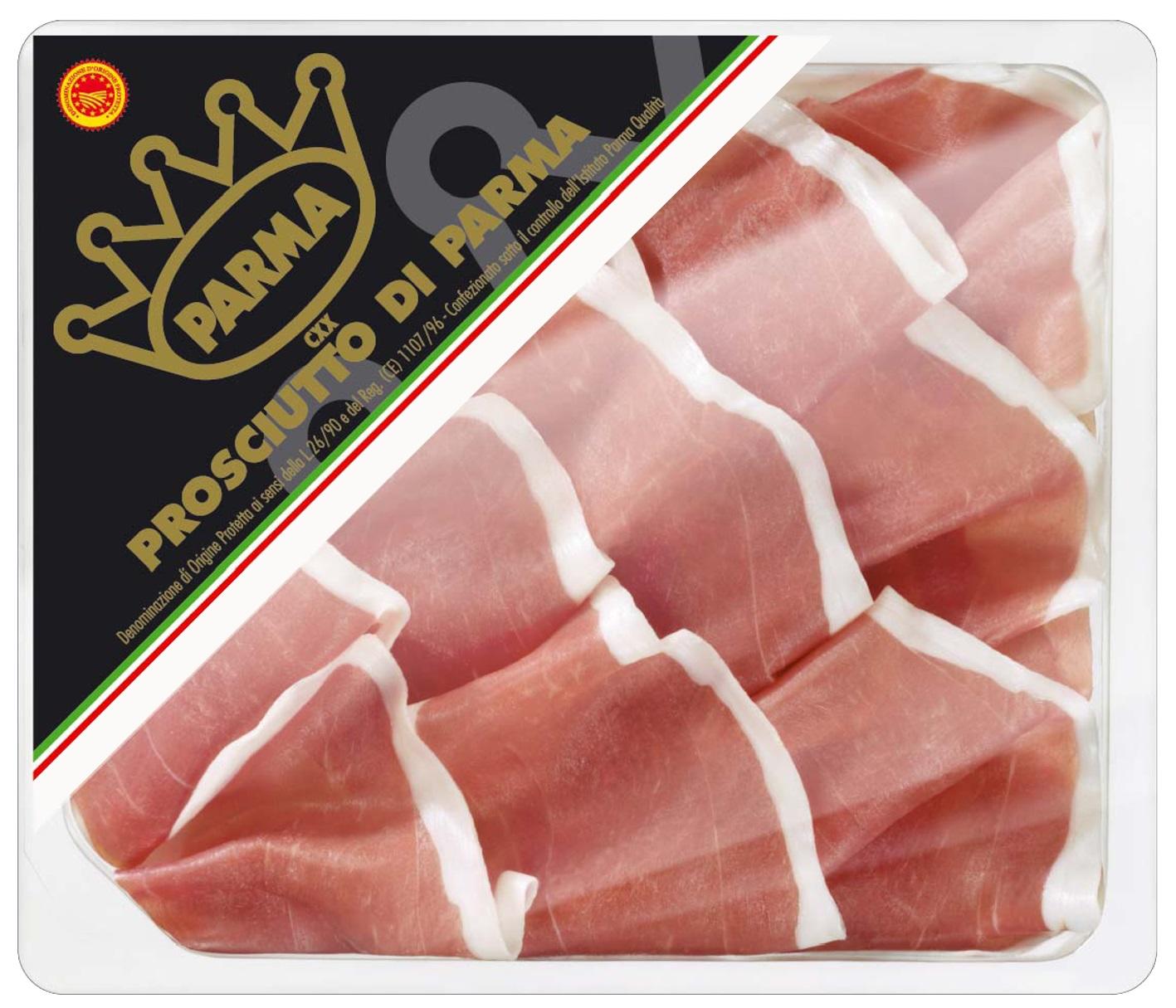Prosciutto di Parma / Parma Ham
| Registration Number | 41 |
|---|---|
| Name of the GI | Prosciutto di Parma,Parma Ham |
| Class | Processed Foodstuffs |
| Date of Protection | 2017/09/15 |
| Producing Area | Overseas |
| Applicant - Name and Address | Consorzio del Prosciutto di Parma, Largo Calamandrei, 1/A, 43100 Parma, Italy http://www.prosciuttodiparma.com/ (Italian) |
Producing Area
Prosciutto di Parma or Parma Ham is a flavorful, cured, raw ham product made by processing selected hind legs of pigs with a minimal quantity of salt to ensure that the meat is tender. When cured, a ham will have lost more than a quarter of its weight through moisture loss, its meat will have become tender and its aroma will have become concentrated. When sliced, the color is uniformly ranging pink to red, marbled with white fat.
Parma Ham is characterized by mild and delicate flavor, slightly salty taste.
Unlike many other hams, the only ingredients in Parma Ham are pork leg and salt. Using additives such as colorings and preservatives like nitrites and nitrates, which are regularly used in processed meats, is prohibited.
【Production Method】
1.Select ingredients
To make Parma Ham, specific breeds of pig, including Large Whites and Landrace, are used. Their diet is a specially regulated blend of grains, cereals and whey which is a by-product of Parmigiano-Reggiano and other cheese. Only castrated pigs in very good health conditions that are at least 9 months of age and average weight of 160 kg with plus or minus 10% are sent to abattoirs for processing.
2.Production method of Parma Ham (up to slicing)
The production of Parma Ham includes the following nine stages.
A) Separation: The hind legs are separated from pork carcasses at the abattoirs.
B) Cooling
C) Trimming: Through trimming, which means removing fat and rind, the ham is given its typical "chicken leg" round shape.
D) Salting:The refrigerated and trimmed pork legs are sent by abattoirs to salting plants, where they are salted by a highly trained maestro salatore or salt master. No chemicals, preservatives or other additives of any kind are used. Hams are not smoked. Hams are then stored in cold rooms for approximately 1 month at a temperature ranging from 1℃ to 4 ℃ at about 80% humidity.
E) Resting: After removing all residual salt, hams are stored in so-called resting rooms for a period ranging from 60 to 90 days at about 75% humidity and at temperatures of 1 - 5 ℃.
F) Washing - Drying: Hams are washed with lukewarm water, after which the rind is scraped to remove any residual salt or impurities. On dry and windy sunny days, hams are dried naturally, otherwise they are dried in special drying rooms.
G) Pre-maturation - Trimming: The hams are hung on the traditional racks known as "scalere".
H) Smearing - The hollow surrounding the best end, exposed muscular part and any cracks are covered with a layer of smear i.e. ground pork fat mixed with a bit salt and ground pepper and, if necessary, rice flour
I) Sampling - Maturation: After smearing and upon reaching the 7th month of age, the hams are moved to the "cellars" for their final curing, which are cooler and less ventilated than pre-maturation rooms. It takes a minimum of 12 months from initial salting to final curing. Finally, the inspectors of the independent agecy CSQA Certificazioni check that products conform to all the processing procedures and carry out quality inspections.
3.Slicing and packaging operations of Parma Ham
The de-boning, preparation, slicing and packaging operations of Parma Ham are carried out in the plants within the production area under the supervision of CSQA Certificazioni.
【Link with the geographical area】
1.Procurement of fodder for the pigs
Pig farming has always existed in the plains and hills of the Po Valley, initially because these areas were covered with oak forests that provided acorns used to fatten omnivorous pigs.
Further, the production area of Parma Ham overlaps with that of Parmigiano-Reggiano cheese. Therefore, whey, a by-product of Parmigiano-Reggiano cheese has been used daily as diet for local pigs since ancient times. Parma Ham is thus produced from pigs that enjoy a diet that includes the whey.
2.Advantage of the production area
The maturation process of Parma Ham requires an environment that is not too humid. The hillside of the Parma region and neighboring areas are ideal for curing ham, because the humidity of these areas is relatively low especially during the summer after slaughtering.
Considering that a minimal quantity of salt is used to bring out the rich, natural flavor of Parma Ham, the environment of the production area, as described above, is essentialy important.
The history of Parma Ham is extremely old, dating back to the second century B.C. The Roman politician Cato the Censor mentions the wonderful aroma of the air-dried ham made around Parma in his book De Agricultura (On Agriculture).
In 1963, a group of 23 ham producers who had hitherto produced cured ham independently founded the Consorzio del Prosciutto di Parma. The purpose of the group is to establish stringent regulations concerning the traditional methods of producing cured ham for protecting, safeguarding the reputation of Parma ham-making, differentiating Parma ham from other cured hams, and assuring its quality.
In 1996, Parma Ham was registered as Protected Designation of Origin (PDO) status by the EU.


